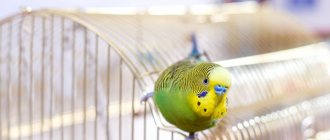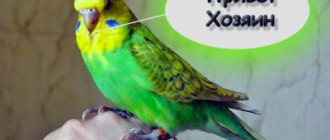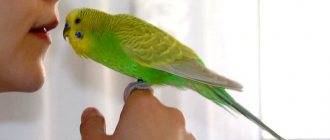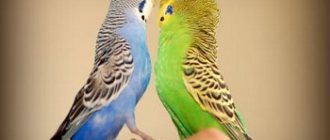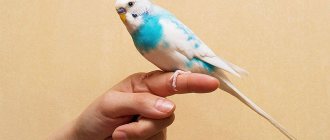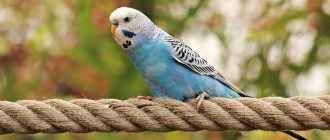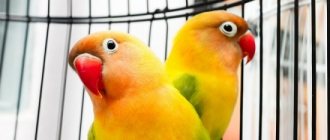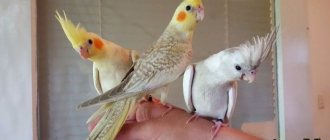Beautiful appearance and bright plumage are one of the reasons for the popularity of lovebirds as pets. In the text below, the reader will find the answer to the question “How to tame a lovebird?”
The experience of keeping this breed of parrots does not confirm the prevailing opinion that they can live exclusively in pairs. With the right approach to the matter, even one individual can be tamed perfectly.
What is important is how the previous owner treated the parrot. Even with a visual inspection, one can draw a conclusion about the conditions in which the pet was previously kept. The bird should be neat, the feathers should not be disheveled, but smooth, the legs and beak should not have abnormal growths. It should be borne in mind that the older the bird, the more difficult it is to tame. Therefore, there is no need to be modest, but directly ask the seller about the age of the lovebird.
Let's start with the fact that settling in a new place, any living creature experiences some kind of stress for some time. For example, unusual smells and long stays on the road have an effect. You can start taming only after the lovebird parrot has completely mastered it in its new home. You must be prepared in advance for the fact that the taming process can take a lot of time. It doesn't hurt to have some patience.
Bird character and behavioral characteristics
Lovebirds are small living creatures. Active, restless and extremely curious. They have very developed emotional intelligence, which is reflected in their intense perception of both negative and positive events.
To establish contact and, subsequently, when taming, it is always necessary to keep this in mind. Igor Ignatenkov
Another feature is that lovebirds are paired creatures. When keeping a pair, the process of getting used to your hands will take a long time. It may not even lead to the desired result.
The character of the parrot and the characteristics of its behavior
Parrots will be too busy with themselves and each other that they will be reluctant to let a third person into their circle. If you do not plan to have a too close relationship with your pet, then get two at once. This way they will be interested and not bored.
It is extremely important for lovebirds to have their own untouchable territory, inaccessible to others. In practice, this is expressed in the fact that it is not worth intruding into the space of the cell beyond what is necessary. Otherwise, establishing contact will be delayed, because the parrot will see you as a rival.
How to make friends and tame a parrot
When a lovebird comes into your home, separated from its usual habitat and its fellows, it experiences extreme stress. Do not rush to surround him with your attention, the pet will perceive this as a threat. Even when moving, you may notice changes in his mood: he becomes silent, does not chirp, withdraws, and behaves anxiously.
Having settled in a new cage, the parrot can often fly from place to place or, conversely, will remain motionless on a perch and will carefully observe everything that happens around it. Or he might hide in a corner in a panic.
Of course, the cage should already be equipped in advance and there should already be food in the feeders and water in the sippy cup. You should not deal with these organizational issues when you have already moved a newcomer into his home. He is still openly afraid of you, and excessive activity around him will seriously complicate further taming.
At what age is it best to tame a parrot?
Getting used to hands is faster in young chicks. You raise a bird by understanding its character, building relationships from scratch.
With more mature lovebirds, the process can take many months or even years, since the bird was previously handled by other people.
There is one more feature associated with the growing up of a pet. He can become tame, but as he grows up, and against the backdrop of hormonal rises, he again becomes wild.
Age at which it is convenient to tame a parrot
Over time, this passes and relationships improve. But perhaps the whole ritual of “domestication” will need to be done again.
Taming a budgerigar in your hands
Where will the bird live and how to quickly raise it? These issues need to be addressed before purchasing a pet. The parrot should live in a spacious cage, where everything is thought out to the smallest detail. Among the required elements are a drinking bowl, a feeder, and perches. The pet must remain in the cage for several days to adapt. When he gets acquainted with the new environment, you can accustom him to holding him. In the future, you can pamper your pet with various toys. The table shows everything that should be in the cell:
After purchasing the parrot, it must be transported to the house in a pre-prepared carrier. This can be a regular cardboard box with holes for ventilation. It is presented in the door of the prepared cage, and the bird itself moves to its new home. You can release a parrot into the wild only where it cannot fly out into the street through a door or window.
Adaptation
After placing the chick in the cage, give it some time to get acquainted with objects unfamiliar to it. For the first two days you shouldn’t bother him at all so that he stops being nervous. Place the house in a quiet place where few people walk. Many owners, already in the first days, are looking for the easiest way to tame a budgie. But there's no need to rush. Give your pet time to adapt. On the second day, you can carefully change the food and water. Touch the paper that covers the tray on about the third day so that a sudden rustle does not frighten the wavy. It is strictly forbidden to use newspapers and magazines, as they contain toxic ink. Accompany all actions you take with kind words.
After placing the chick in the cage, give it some time to get acquainted with objects unfamiliar to it.
The first days after purchase the bird experiences severe stress. The reason is the new environment and separation from fellow humans. She usually sits hunched over and hardly eats. In a couple of days everything should change.
Upbringing
Before you communicate closely with a bird, you need to determine what its temperament is. If you watch her, you can understand how to quickly tame a smart budgie. However, all birds have their own character. Some pets are very playful, others are calmer. The first one makes contact easily, as they are distinguished by their curiosity. Independent birds are more difficult to tame, but with the right approach they will definitely trust you.
During the first few days, you should not let your pet out of the cage - he is not yet completely accustomed to his new home and returning him will be problematic. If you try to catch a bird that does not know its hands and does not know how to return to its home, it will be difficult to catch it. She will fly under the ceiling and hide on cabinets, where it is almost impossible to get her. In addition, a frightened pet may fall and get hurt.
How to gain trust
To establish contact with the wavy, all your manipulations should be associated only with something pleasant, for example, a treat.
When starting training, extend your hand with food into the cage.
When starting training, extend your hand with food into the cage. If the bird is in the wild, immediately close all doors and windows, remove animals from the premises that can scare it. Give your pet time so that he can stop being nervous and get hungry. After five hours, the parrot will want to eat and will approach the house with food and water. Usually birds climb into hard-to-reach places, so there is no point in chasing them. Leave the door open and equip the entrance with comfortable perches. When the pet stops being nervous, he will be able to fly up to the home and enter it. Watch him carefully, but do not show obvious interest. When the bird is in the cage, slam the door.
Step-by-step instructions for taming a parrot
So, you have acquired a wonderful pet. And you feel a natural desire for the lovebird to become part of your family and join your social circle as soon as possible. What do I need to do?
Adaptation to a new place and family members
Is your parrot walking?
Not really
We have already said above that lovebirds are very emotional birds. Therefore, be calm. Prohibit all household members from any physical contact with the new resident. When talking to him, you don’t need to shout, scare, or call out sharply. Let him get used to the new place and get to know the whole family.
Feed and change drinking water regularly. If the lovebird is afraid to approach the feeder, at the first stage you can sprinkle grains and treats next to the bird.
Place the cage so that it is level with your eyes. When you look at a bird from above, it instinctively feels a threat to itself. If you are shorter, the lovebird will imagine himself to be the dominant alpha in the relationship and contact will not take place.
Confidence
When you notice that a bird blinks in the presence of a person, cleans its feathers and even goes about its business, it means that it has become accustomed to you and the new environment. You can move on to a new stage.
Read also
How to determine the age of a lovebird
Now is the time to start getting to know each other better. Be very careful to place your finger near your parrot while feeding so that he can sit on it or walk on it. After this exercise is performed calmly and naturally, you can move on.
When you release your parrot from its cage, invite it to ride on your hand. To do this, place your pet in your palm. Over time, the lovebird will associate these two moments, those. stomp, holding tightly on the finger, and when turning the hand, change to the palm.
The parrot must trust
When a trusting relationship and the first contact have taken place, you can expand joint actions - everything will go faster.
How much time to devote to your pet?
It depends on the nature of the lovebird. If the bird makes contact and shows friendliness, then you can work with it longer, offer new exercises, try games.
Consider the fact that parrots are very active creatures, which means they get tired faster. 30 to 40 minutes of exercise per day is sufficient.
Getting to know the bird
Lovebirds get along well with people, but mutual trust does not appear immediately. When you first meet, it is difficult to guess how the future relationship will develop. For successful upbringing, the bird must be young, active, and cheerful. It will be much more difficult to tame an adult with character.
Everything should be ready for the arrival of a new pet in the house:
- a cozy corner in the room has been selected;
- a spacious cage with the necessary utensils and toys is installed;
- there is fresh food in the feeder;
- The drinking bowl is filled with clean water.
Attention! Hang the cage on the wall or place it on a shelf at eye level, this will make it easier to communicate. Make sure that the parrot's home is inaccessible to pets and children.
Important Tips
Over the long period of keeping these parrots, breeders have developed many methods that affect the speed of their taming.
Application of toys
If a lovebird has a favorite trinket, then it will be a good help in joint developmental activities. To begin, place the toy on your palm so that the parrot can pick it up without touching you.
Give your parrot his favorite toy
Then you can place the object higher on the hand to make tactile contact. Move it in this way until the bird climbs onto your shoulder and sits on it.
By assessing the bird's character, you can independently come up with entertainment using new toys, or those that your feathered friend likes to tinker with.
We use treats
This method is best considered as an auxiliary one. Indulging in treats can have a negative impact on your pet's health. Therefore, keep it in moderation.
It can become a good tradition in relationships to reward with a treat at the end of classes, and during the learning process make do with a kind word and praise.
During the first stage of taming a bird, a treat can break down the wall of mistrust between you and the parrot. Therefore, if no amount of persuasion and tricks help, then use goodies as bait.
Give your parrot a treat
What not to do
Until your parrot becomes tame enough, handle him very carefully, respecting personal boundaries. Lovebirds are vindictive; they do not forgive the owner for rude behavior.
- Do not look the parrot directly in the eyes, fix your gaze below the beak. Natural instinct will tell the bird that you are an enemy if your eyes meet.
- Don't yell at the bird, restrain your emotions. Raising your voice will not achieve obedience, but only rejection.
- Do not let your lovebird out of the cage while it is adapting. Returning on your own is almost impossible, and by forcing it you will destroy the bird’s fragile trust.
- Do not catch a pet that has escaped into freedom. The bird has an instant reaction, and in an attempt to return it to its place, you will lose. Most likely, the result will be psychological or physical trauma to the parrot. Wait until he decides to return.
- Do not wrap the bird in a towel to keep it close to you. This technique should be used only when absolutely necessary.
Taming a lovebird requires a gentle approach. A wayward bird becomes tame when it recognizes a person as the head of the flock. You shouldn’t expect boundless trust from a lovebird - this parrot seems to stay slightly aloof, always on guard.
Fighting bites
Lovebirds bite. It is a fact. They do this for several reasons, namely how:
- a method of tactile examination of the environment; the beak is a bird's hand;
- protection; if the parrot feels threatened and cannot fly away, it will bite;
- aggression; males during the rut and females during the period of hormonal peak can bite everyone they consider rivals or even everyone they can reach.
Food selection
It is better to feed a new resident in the house once every few hours. It is necessary to give food little by little, thanks to which the pet will get used to the owner and will see him as the breadwinner. After some time, it will become clear that the lovebird has become accustomed to its new owner. After this, you can often stand near the cage, talking to him quietly. You need to move smoothly and not make any noise. After a few days, the parrot will stop paying attention to the owner’s manipulations with his house, which directly indicates addiction. After this, you can begin direct contact with the bird.
What to do?
- Immediately stop playing and exercising together.
- Say sternly, but don’t shout, a safe word, for example: “No”, “No”.
- Change the position of the place where the parrot is. For example, a bird sits on your hand and pecks your finger. You need to lower your hand, then the bird will lose support and retreat from your finger. After this, immediately put the biter in a cage.
- Over time, you will begin to understand when your pet decided to bite and you will be ready for aggression. In this case, it is useful to have a twig or stick on hand. As soon as your intentions are clear, put this branch in the parrot’s beak and let him gnaw on the piece of wood.
What to do when a parrot bites - The method is not very humane, but safe. This is 100% peppermint oil. If the places of your favorite bites are known, then you can smear them with the product. The effectiveness of this method of weaning off bites is very significant. Plus, the bird does not perceive the smell, stops pecking, as it is unpleasant, and the person lubricates the wounds with healing oil.
Over time and as the parrot matures, it becomes aggressive again. The lovebird will still use its beak, perhaps not at full strength, but only by grabbing the owner’s skin. Some regard this as a manifestation of love, a good mood, a cheerful and playful mood of a lovebird.
Lovebird at home: preparing the home
These birds are small (body length does not exceed 20 centimeters), with bright plumage. They are distinguished by a small but very strong beak. That is why you should be careful when handling them, as you can get quite serious injuries.
Representatives of this species live quite a long time - on average 15–20 years. They are quite capricious and can even be aggressive towards representatives of other species.
Check out the types of lovebirds.
If you decide to have a lovebird at home, you should first make sure that he is comfortable:
- cell - despite the small size of the lovebird, its home should be spacious. This is due to the fact that the bird is active, loves to play and climb. It is very important that the rods and bottom are metal, since the parrot will quickly chew wood or plastic;
- dishes - make sure that the drinking bowl and feeder are at some distance from each other. So that the food does not get into the water, and the water does not get wet and thus spoil the food;
- entertainment - be sure to install a small ladder in the cage, hang a few toys and a small mirror. Then in your absence the bird will not be bored;
- leisure - in addition, parrots of this species really like to chew something. A twig of any fruit tree is ideal for these purposes. Just keep in mind that if you live in a big city, then before giving the branch to the bird, you need to pour boiling water over it. This is necessary in order to wash away harmful substances from which the parrot can get sick.
When the home is ready, a new pet can be placed there.
Important! If you decide to get yourself a lovebird, then you should choose a younger bird.
This is due to the fact that they make contact better.
What is prohibited to do
Everything you don’t want to feel about yourself. It is forbidden:
- Beat the parrot. You will harm his health and forever lose the opportunity to establish contact. This will be your complete failure as both a companion and a pet friend.
- Yelling is stressful and a loss of confidence.
- Forcibly holding a bird in your hands will absolutely lead to the exact opposite effect.
Taming a parrot: First steps. How to teach a parrot to eat from your hands and sit on your hands [POPS: Taming]
The process of taming a lovebird
One of the effective techniques that works with almost 90 percent probability is the use of various treats. For example, cut a small slice from a carrot, sweet pepper or apple and, approaching the cage, try to carefully push the treat between the metal bars. It is advisable to pronounce words and phrases good-naturedly. The list of delicacies can be supplemented with grapes, dandelion leaves and lettuce.
Patient but persistent action will eventually lead to associations between the treats and the person. Now they move on to the next stage - giving treats through the open door and even outside the cage. Eventually, the lovebird will get used to it so much that it will even climb onto the palm of your hand. As a treat, it is best to use fruits that the lovebird can eat.
To tame these parrots, another effective technique is often used. Lightly stick your hand with a mirror, a bell or a small ball and wait for the parrot to respond to the invitation to start playing.
In each individual case, the individual characteristics of the lovebird’s character should be taken into account. Don't expect the above recommendations to work smoothly. The only wish that remains unchanged is to be patient and never raise your voice to the bird.
What to do if the bird does not make contact?
There are times when all efforts and tricks were in vain. The parrot does not want to sit on your hand or shoulder, and does not understand the simple command: “No.” This happens sometimes. Perhaps the bird is not healthy or is experiencing stress.
Read also
How to trim the claws of a Corella parrot at home
If both health and emotional state are normal, then apparently this is the case when the bird simply cannot be tamed.
What to do in such cases? If the lovebird is lonely, then it is best to pick up and place a couple in the cage. The company is interesting in life and the two of them will have a good time.
General tips for keeping lovebirds
In order for a parrot to treat its owner well and love him, he needs to be provided with comfortable living conditions. It’s better to ask yourself in advance how to tame a lovebird and prepare everything you need. Buy a feeder, a drinking bowl, a variety of toys, and a swing. It is very important that the bird is healthy, well-fed and cheerful.
It is advisable to purchase not just one parrot, but a pair, so that one does not get bored when the owner is away for a long time. In nature, lovebirds prefer to find a mate for life, but if the other half dies, then the bird may well get along well in a new family. Therefore, a lovebird can live quite calmly alone in a cage.
To understand how to tame lovebirds, you need to be very attentive to them, since each bird has its own character and different experiences of previous relationships with humans.
A new environment is no reason to be afraid
If you want to become a true friend to your parrot, be patient. You will have to spend a lot of time taming. The lovebird should stop being afraid of you. Only in a calm state, completely accustomed to you, will he want to communicate with you.
In the first days of the bird's appearance in your home, do not even try to establish a close relationship with your pet. Moving from a native nest to a foreign place is a great stress for a lovebird. If you start to climb into his cage and try to pet him, the parrot will take this as a threat. Once you frighten a bird, it will be difficult to change the situation and convince it that there is nothing to fear.
While the lovebird is getting used to the new environment, try to go into the room allocated for him as little as possible. Carefully changing food and water, cleaning the cage - no more actions. The rest of the time, keep the door to the room closed so that extraneous noises, people and animals do not terrify the parrot.
Perhaps the lovebird is so frightened by the change of housing that it is afraid to approach an unfamiliar feeder. Place some seeds at the bottom of the cage. This way you will do two things at once: show concern and not leave the parrot hungry. A broad gesture can attract the bird towards you.
A sign that the bird is beginning to trust you will be the lovebird's calmness when you approach. Bird food is a great way to bond. Try to feed your parrot little by little, but every three to four hours. The bird must understand that you are a good provider who will not harm it. Start talking quietly and affectionately to your pet, spend more time near the cage. The main thing is no sudden movements or loud sounds.
Main characteristics of lovebirds
Lovebirds are small parrots with a relatively large head. The color of the plumage is predominantly green, but there are other colors, especially in certain parts of the body. Lovebirds have a strong beak, which can cause serious wounds. These birds are distinguished by their agility and dexterity, they move well on the ground and trees, creating nests in hollows for which they use various twigs, grass, and bark elements. They are good builders. They live in flocks, mainly in tropical forests. They fly nimbly and quickly. They spend the night in trees.
Lovebird games and training
Many people keep parrots for one purpose: to teach the bird to speak and imitate the voice of the owner. We will tell you the basic rules that will speed up the learning process and make it easier.
So, in order for your chick to speak, you should remember that:
- The parrot perceives women's and children's voices best.
- Training is required to be carried out every day at the same time, preferably before feeding the birds.
- The duration of the workout should be at least 10-20 minutes.
- Don't try to teach your parrot whole phrases at once. Start with simple letters and syllables. They need to be repeated several times and always with the same intonation. If you get tired of patiently repeating the same thing, then use a voice recorder. Write down the necessary letters/words and turn them on by placing the sound source near the cage.
Lovebird diseases at home and treatment methods
The main causes of lovebird diseases are improper care. For example, an intestinal infection develops from expired food and unsanitary conditions in the cage.
Colds can occur due to frequent drafts, and if parrots are not fed enough, they will develop vitamin deficiency.
It is also necessary to monitor the psychological state of pets. If you pay little attention to them, they will begin to feel depressed and pluck themselves.
Infectious diseases that birds can suffer from include psittacosis and salmonellosis. Parasitic diseases include knemidocoptic mange and helminthiasis.
In mild cases, the bird can heal on its own; in advanced cases, you should consult a veterinarian. Lack of medical care will lead to the death of the parrot.
In nurseries, chicks are vaccinated against a large number of diseases. At six months they are vaccinated against rabies.
